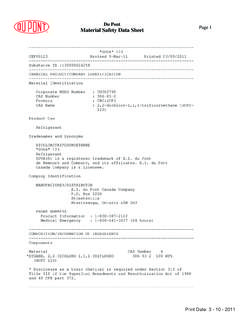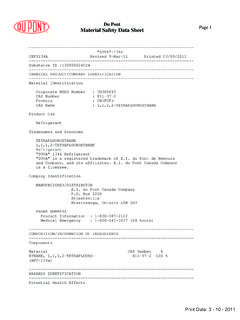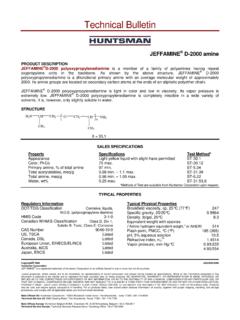Transcription of Retrofit Guidelines for DuPont ISCEON MO99 (R-438A ...
1 Technical informaTionDuPont ISCEON Retrofit Guidelines foR DuPont ISCEON M099 (R-438A) REfRIGERAnttAblE of ContEntS PageIntroduction ..2 Retrofit Choice ..2 Easy Steps to Retrofit ..2 Important Safety Information ..3 Flammability ..3 Filter Drier and Elastomeric Seal Information ..3 General Retrofit Information ..4 System Modifications ..4 Lubricants and System Oil Management.
2 4 Liquid Refrigerant Control ..6 Refrigerant Recovery Information ..7 Expected Performance After Retrofit ..7 Detailed Retrofit Procedure ..8 Pressure-Temperature Charts ..10 How to Read the Pressure/Temperature Tables ..10 How to Determine Suction Pressure, Superheat, and Subcool ..10 Retrofit Checklist ..11 System Data ..14PT Charts ..152 IntRoDuCtIonDuPont ISCEON refrigerants have proven to be reliable and cost-effective non-ozone-depleting Retrofit refrigerants. In many cases, systems converted to these refrigerants are operating with the same mineral oil or alkylbenzene lubricant that was used with the previous CFC or HCFC refrigerant.
3 ISCEON refrigerants have been shown to provide similar system performance as when operating with the previous refrigerant. Using these Retrofit Guidelines , direct expansion (DX) residential and commercial air conditioning (AC), and medium and low temperature refrigeration systems containing R-22 can be easily and economically converted to ISCEON mo99 . This allows existing equipment to continue operating safely and effectively for the remainder of its useful Choice for R-22 Direct Expansion Systems in Residential and Commercial Air Conditioning, Direct Expansion Chillers, Medium and low temperature Refrigeration ISCEON mo99 is a non-ozone-depleting HFC Refrigerant designed to replace R-22 in existing direct expansion (DX) residential and commercial air conditioning (AC) and medium- and low-temperature refrigeration systems.
4 ISCEON mo99 is compatible with traditional and new lubricants; in most cases no change of lubricant type during Retrofit is return is determined by a number of operating and design conditions in some complex systems, polyol ester lubricant (POE) may need to be added. Minor equipment modifications ( , seal replacement) or expansion device adjustments may be required in some experience has shown that ISCEON mo99 provides performance that meets customer requirements in most properly retrofitted systems. ISCEON mo99 provides similar cooling capacity and energy efficiency to R-22 in most systems, while operating at a lower compressor discharge temperature.
5 Actual performance depends on system design and operating conditions. Systems using ISCEON mo99 are easy to service. ISCEON mo99 can be topped off during service without the need to remove the entire refrigerant charge. The cause of any refrigerant loss should be investigated and corrected as soon as : When servicing critically charged systems, all of the refrigerant charge should be removed. This is the same practice recommended for general, ISCEON mo99 refrigerant is not recommended for use in centrifugal compressor systems or for chillers with flooded evaporators.
6 For system-specific guidance on working with HFC blends in semi-flooded operations with low-pressure receivers, contact DuPont or consult the OEM. Easy Steps to RetrofitThe following provides a summary of the basic Retrofit steps for ISCEON mo99 . (Detailed discussion of each step is provided in this bulletin.)1. Establish baseline performance with existing refrigerant. (See enclosed Retrofit checklist)2. Remove existing refrigerant (R-22 or other) from the system into a recovery cylinder. Weigh the amount Replace the filter drier and critical elastomeric seals/gaskets.
7 *4. Evacuate system and check for Charge with ISCEON mo99 . Remove as a liquid only from charging cylinder. The initial charge amount should be approximately 85% of the standard charge for R-22. The final charge amount will vary by system, but will be approximately the same weight as with Start up system, monitor, adjust TXV and/or charge size to achieve optimum Monitor oil levels in compressor. Add oil as required to maintain proper Label system for the refrigerant and lubricant used.*Critical Seals are ones that are difficult to isolate and/or service while operating or require removal of the entire refrigerant charge, liquid receiver level gauge, in order to SAfEty InfoRMAtIonLike CFCs and HCFCs, ISCEON refrigerants are safe to use when handled properly.
8 However, any refrigerant can cause injury or even death when mishandled. Please review the following Guidelines and consult the product MSDS, including proper personal protective equipment recommendations, before using any refrigerant. At a minimum, appropriate hand (gloves) and eye (safety glasses) protection should be used. Do not work in high concentrations of refrigerant vapors. Always maintain adequate ventilation in the work area. Do not breathe vapors. Do not breathe lubricant mists from leaking systems. Ventilate the area well after any leak before attempting to repair equipment.
9 Do not use handheld leak detectors to check for breathable air in enclosed working spaces. These detectors are not designed to determine if the air is safe to breathe. Use oxygen monitors to ensure adequate oxygen is available to sustain life. Do not use flames or halide torches to search for leaks. Open flames ( Halide detection torches, or brazing torches) can release large quantities of acidic compounds in the presence of all refrigerants, and these compounds can be hazardous. Halide torches are not effective as leak detectors for HFC refrigerants; they detect the presence of Chlorine, which is not present in ISCEON mo99 , and consequently, these detectors will not detect the presence of this refrigerant.
10 Use an electronic leak detector designed to find the refrigerants you are using. If you detect a visible change in the size or color of a flame when using brazing torches to repair equipment, stop work immediately and leave the area. Ventilate the work area well and stop any refrigerant leaks before resuming work. These flame effects may be an indication of very high refrigerant concentrations, and continuing to work without adequate ventilation may result in injury or : Any refrigerant can be hazardous if used improperly.







